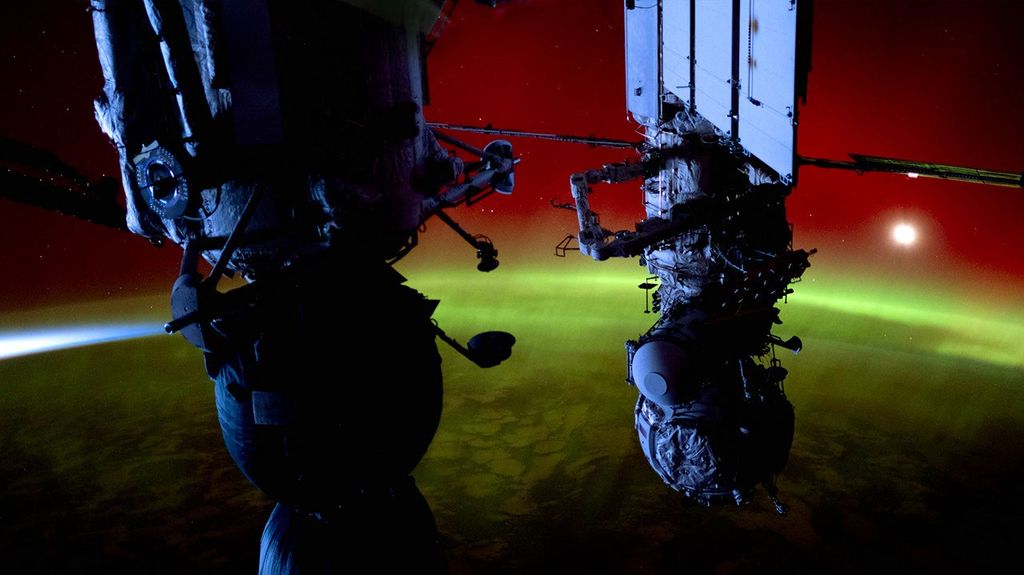1 min read
Hubble Illuminates Cluster of Diverse Galaxies

This image from NASA's Hubble Space Telescope shows the diverse collection of galaxies in the cluster Abell S0740 that is over 450 million light-years away in the direction of the constellation Centaurus.
The giant elliptical ESO 325-G004 looms large at the cluster's center. The galaxy is as massive as 100 billion of our suns. Hubble resolves thousands of globular star clusters orbiting ESO 325-G004. Globular clusters are compact groups of hundreds of thousands of stars that are gravitationally bound together. At the galaxy's distance they appear as pinpoints of light contained within the diffuse halo.
Other fuzzy elliptical galaxies dot the image. Some have evidence of a disk or ring structure that gives them a bow-tie shape. Several spiral galaxies are also present. The starlight in these galaxies is mainly contained in a disk and follows along spiral arms.
This image was created by combining Hubble science observations taken in January 2005 with Hubble Heritage observations taken a year later to form a 3-color composite. The filters that isolate blue, red and infrared light were used with the Advanced Camera for Surveys aboard Hubble.
About the Object
- R.A. PositionR.A. PositionRight ascension – analogous to longitude – is one component of an object's position.13h 43m 33.3s
- Dec. PositionDec. PositionDeclination – analogous to latitude – is one component of an object's position.-38° 10' 33.99"
- ConstellationConstellationOne of 88 recognized regions of the celestial sphere in which the object appears.Centaurus
- DistanceDistanceThe physical distance from Earth to the astronomical object. Distances within our solar system are usually measured in Astronomical Units (AU). Distances between stars are usually measured in light-years. Interstellar distances can also be measured in parsecs.Approximately 463 million light-years (142 Megaparsecs)
- DimensionsDimensionsThe physical size of the object or the apparent angle it subtends on the sky.Roughy 2.9 arcminutes (385,000 light-years or 120 kiloparsecs) wide.
About the Data
- Data DescriptionData DescriptionProposal: A description of the observations, their scientific justification, and the links to the data available in the science archive.
Science Team: The astronomers who planned the observations and analyzed the data. "PI" refers to the Principal Investigator.The Hubble image was created from HST data from proposal 10429: PI: J. Blakeslee (Washington State University), J. Lucey and R. Smith (University of Durham), J. Tonry (University of Hawaii), and S. Mei (Johns Hopkins University); and 10710: K. Noll, H. Bond, C. Christian, L. Frattare, F. Hamilton, Z. Levay, M. Mutchler, W. Januszewski, and T. Royle (Hubble Heritage Team/STScI), and J. Blakeslee (Washington State University). - InstrumentInstrumentThe science instrument used to produce the data.HST>ACS/WFC
- Exposure DatesExposure DatesThe date(s) that the telescope made its observations and the total exposure time.January 2005 - February 2006
- FiltersFiltersThe camera filters that were used in the science observations.F475W (g), F625W (r), and F814W (I)
- Object NameObject NameA name or catalog number that astronomers use to identify an astronomical object.ESO 325-G004, Abell S0740
- Object DescriptionObject DescriptionThe type of astronomical object.Giant Elliptical Galaxy and its Host Galaxy Cluster
- Release DateFebruary 5, 2007
- Science ReleaseHubble Illuminates Cluster of Diverse Galaxies
- CreditNASA, ESA, and The Hubble Heritage Team (STScI/AURA); Acknowledgment: J. Blakeslee (Washington State University)

This image is a composite of many separate exposures made by the ACS instrument on the Hubble Space Telescope using several different filters. Three filters were used to sample broad wavelength ranges. The color results from assigning different hues (colors) to each monochromatic image. In this case, the assigned colors are: Blue: F475W (g) Green: F625W (r) Red: F814W (I)

Related Images & Videos

ESO 325-G004: Detailing the Big Picture
Evident from the Hubble image is the fact that ESO 325-G004 is home to thousands of globular clusters, small compact groups of hundreds of thousands of stars that are gravitationally bound systems. These clusters are dispersed spherically and uniformly in the outer halo of the...
Share
Details
Claire Andreoli
NASA’s Goddard Space Flight Center
Greenbelt, Maryland
claire.andreoli@nasa.gov































